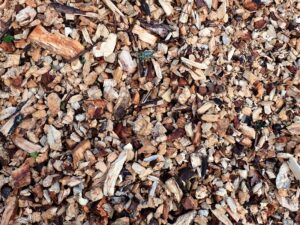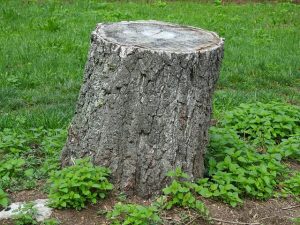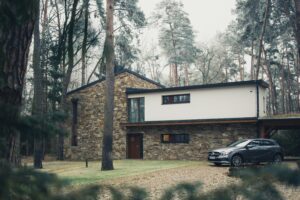Wood Chipping Near Me

Wood Chipping Near Me
Woodchips are small- to medium-sized pieces of wood formed by cutting or chipping larger pieces of wood such as trees, branches, logging residues, stumps, roots, and wood waste.
Woodchips, with hand for scale
Woodchips may be used as a biomass solid fuel and are raw material for producing wood pulp. They may also be used as an organic mulch in gardening, landscaping, and ecosystem restoration; in bioreactors for denitrification; and as a substrate for mushroom cultivation.
The process of making woodchips is called wood chipping and is done using a wood chipper. The types of woodchips formed following chipping is dependent on the type of wood chipper used and the material from which they are made. Woodchip varieties include: forest chips (from forested areas), wood residue chips (from untreated wood residues, recycled wood and off-cuts), sawing residue chips (from sawmill residues), and short rotation forestry chips (from energy crops).
Raw materials
The raw materials of woodchips can be pulpwood, waste wood, and residual wood from agriculture, landscaping, logging, and sawmills. Woodchips can also be produced from remaining forestry materials including tree crowns, branches, unsaleable materials or undersized trees.
Wood chipper
Forestry operations provide the raw materials needed for woodchip production. Almost any tree can be converted into woodchips, however, the type and quality of the wood used to produce woodchips depends largely on the market. Softwood species, for instance, tend to be more versatile for use as woodchips than hardwood species because they are less dense and faster growing.
Production
A wood chipper is a machine used for cutting wood into smaller pieces (chips). There are several types of wood chippers, each having a different use depending on the type of processing the woodchips will undergo.
Pulp and paper industry
Woodchips used for chemical pulp must be relatively uniform in size and free of bark. The optimum size varies with the wood species. It is important to avoid damage to the wood fibers as this is important for the pulp properties. For round wood it is most common to use disk chippers. A typical size of the disk is 2.0–3.5 m in diameter, 10–25 cm in thickness and weight is up to 30 tons. The disk is fitted with 4 to 16 knives and driven with motors of ½ –2 MW. Drum chippers are normally used for wood residuals from saw mills or other wood industry.
Methods of conveyance
There are four potential methods to move woodchips: pneumatic, conveyor belt, hopper with direct chute, and batch system (manual conveyance).
Types of wood chippers
Disk
A disk wood chipper features a flywheel made of steel and chopping blades with slotted disks. The blades slice through the wood as the material is fed through the chute. Knives located in the throat of the chipper cuts the wood in the opposite direction. The design is not as energy efficient as other styles but produces consistent shapes and sizes of woodchips.
Drum
A drum wood chipper has a rotating parallel-sided drum attached to the engine with reinforced steel blades attached in a horizontal direction. Wood is drawn into the chute by gravity and the rotation of the drum where it is broken up by the steel blades. The drum type is noisy and creates large uneven chips but are more energy efficient than the disk type.
Screw-type
A screw-type wood chipper contains a conical, screw-shaped blade. The blade rotation is set parallel to the opening so wood is pulled into the chipper by the spiral motion. Screw-type, also called high-torque rollers, are popular for residential use due to being quiet, easy to use and safer than disk and drum types.
Applications
Woodchips are used primarily as a raw material for technical wood processing. In industry, processing of bark chips is often separated after peeling the logs due to different chemical properties.
Wood pulp
Only the heartwood and sapwood are useful for making pulp. Bark contains relatively few useful fibers and is removed and used as fuel to provide steam for use in the pulp mill. Most pulping processes require that the wood be chipped and screened to provide uniform sized chips.
Mulch
Woodchips are also used as landscaping and garden mulch, for water conservation, weed control, and reducing and preventing soil erosion. Woodchips when used as a mulch are at least three inches thick. It has a mixed reputation in gardening.
It has been promoted for use in habitat restoration projects. As the radial chipped wood decomposes it improves the soil structure, permeability, bioactivity, and nutrient availability of the soil.
Playground surfacing
Woodchips do not meet American Society for Testing and Materials standards for use as playground surfacing material, and as of 2011 are illegal to use as playground surfacing in the US, not being ADA-approved according to US department of Justice guidelines.
Barbecuing
Woodchips can also be used to infuse flavor and enhance the smoky taste to barbecued meats and vegetables. Several different species of wood can be used depending on the type of flavor wanted. For a mild, sweet fruity flavor, apple wood can be used while hickory gives a smoky, bacon-like flavor. Other different types of wood used are cherry, mesquite and pecan.
Denitrifying woodchip bioreactor
Woodchips can be loaded into a ‘denitrifying woodchip bioreactor’ which has been used for several decades as an emerging biotechnology to treat agricultural wastewater by removing nitrates. It is a subsurface system where denitrification by micro-organisms utilizing a carbon source (as electron donor) reduces the nitrate into a harmless nitrogen gas. Denitrifying woodchip bioreactor have a low construction and operational costs with a comparatively long lifespan going up to 15 years. The interest in such a technique has grown in recent years and has expanded into the mining industry.
A 2013 experiment showed that after 70 days of startup, a woodchip pile loaded with liquid pig manure at 5 L/m2/day removed an average of 90% of nitrate after one month. However, if the environmental conditions do not support complete denitrification, undesirable greenhouse gas such as nitrous oxide gas and methane could be produced.
Fuel
Woody chips left for drying before transport to industrial off-takers in Namibia. Woodchips have been traditionally used as solid fuel for space heating or in energy plants to generate electric power from renewable energy. The main source of forest chips in Europe and in most of the countries [which?] have been logging residues. It is expected that the shares of stumps and round wood will increase in the future. As of 2013 in the EU, the estimates for biomass potential for energy, available under current 2018 conditions including sustainable use of the forest as well as providing wood to the traditional forest sectors, are: 277 million m3, for above ground biomass and 585 million m3 for total biomass.
The newer fuel systems for heating use either woodchips or wood pellets. The advantage of woodchips is cost, the advantage of wood pellets is the controlled fuel value. The use of woodchips in automated heating systems, is based on a robust technology.
The size of the woodchips, moisture content, and the raw material from which the chips are made are particularly important when burning wood chips in small plants. Unfortunately, there are not many standards to decide the fractions of woodchip.
The energy content in one cubic meter is normally higher than in one cubic meter wood logs, but can vary greatly depending on moisture. The moisture is decided by the handling of the raw material. If the trees are taken down in the winter and left to dry for the summer (with teas in the bark and covered so rain can’t reach to them), and is then chipped in the fall, the wood chips’ moisture content will be approximately 20–25%. The energy content, then, is approximately 3.5–4.5kWh/kg (~150–250 kg/cubic meter).
Coal power plants have been converted to run on woodchips, which is fairly straightforward to do, since they both use an identical steam turbine heat engine, and the cost of woodchip fuel is comparable to coal.
Solid biomass is an attractive fuel for addressing the concerns of the energy crisis and climate change, since the fuel is affordable, widely available, close to carbon neutral and thus climate-neutral in terms of carbon dioxide (CO2), since in the ideal case only the carbon dioxide which was drawn in during the tree’s growth and stored in the wood is released into the atmosphere again.
Waste and emissions
Compared to the solid waste disposal problems of coal and nuclear fuels, woodchip fuel’s waste disposal problems are less grave; in a study from 2001 fly ash from woodchip combustion had 28.6 mg cadmium/kg dry matter. Compared to fly ash from burning of straw, cadmium was bound more heavily, with only small amounts of cadmium leached. It was speculated as a form of cadmium oxide, cadmium silicate (CdSiO3); authors noted that adding it to agricultural or forest soils in the long-term could cause a problem with accumulation of cadmium.
Like coal, wood combustion is a known source of mercury emissions, particularly in northern climates during winter. The mercury is both gaseous as elemental mercury (especially when wood pellets are burned) or mercury oxide, and solid PM2.5 particulate matter when untreated wood is used.
When wood burning is used for space heating, indoor emissions of 1, 3-butadiene, benzene, formaldehyde and acetaldehyde, which are suspected or known carcinogenic compounds, are elevated. The cancer risk from these after exposure to wood smoke is estimated to be low in developed countries.
Certain techniques for burning woodchips result in the production of bio char – effectively charcoal – which can be either utilized as charcoal, or returned to the soil, since wood ash can be used as a mineral-rich plant fertilizer. The latter method can result in an effectively carbon-negative system, as well as acting as a very effective soil conditioner, enhancing water and nutrient retention in poor soils.
About Centerville, Utah
Centerville is a city in southeastern Davis County, Utah, United States. Centerville is part of the Ogden-Clearfield Metropolitan Statistical Area. The population was 15,335 at the 2010 census. It is located adjacent to the easternmost part of the Great Salt Lake.
Neighborhoods in Centerville, Utah
Williams West, Sunset Heights, Placid Cove, Chase Lane Estates, Pitford Acres, North Hillsdale, Arcadia, Aegean Village, Forest Park, Centerville, Packlynn, North Ridge, Willow Farm Estates
Things To Do in Centerville, Utah
Bus Stops in Centerville, Utah to Truco Services, Inc.
Bus Stop in Main St @ 243 N (Centerville) Centerville, Utah to Truco Services, Inc.
Bus Stop in Main St @ 1198 N (Centerville) Centerville, Utah to Truco Services, Inc.
Bus Stop in Main St @ 876 S (Centerville) Centerville, Utah to Truco Services, Inc.
Bus Stop in Main St @ 1550 N (Bountiful) Centerville, Utah to Truco Services, Inc.
Bus Stop in Main St @ 75 S Centerville, Utah to Truco Services, Inc.
Bus Stop in Main St @ 402 S (Centerville) Centerville, Utah to Truco Services, Inc.
Bus Stop in Main St @ 1201 N (Centerville) Centerville, Utah to Truco Services, Inc.
Bus Stop in Main St @ 98 N Centerville, Utah to Truco Services, Inc.
Bus Stop in Main St @ 975 N Centerville, Utah to Truco Services, Inc.
Bus Stop in Main St @ 1440 N Centerville, Utah to Truco Services, Inc.
Bus Stop in Main St @ 401 S Centerville, Utah to Truco Services, Inc.
Bus Stop in Main St @ 611 N Centerville, Utah to Truco Services, Inc.
Driving Directions in Centerville, Utah to Truco Services, Inc.
Driving Directions from Pine valley tree service to 4640 Commerce Dr, Murray, UT 84107, USA
Driving Directions from Nubbs Stump Removal to 4640 Commerce Dr, Murray, UT 84107, USA
Driving Directions from Blake's Trees LLC to 4640 Commerce Dr, Murray, UT 84107, USA
Driving Directions from Professional Tree and Stump Removal to 4640 Commerce Dr, Murray, UT 84107, USA
Driving Directions from Acer Trees to 4640 Commerce Dr, Murray, UT 84107, USA
Driving Directions from Steve's Trees, Inc. to 4640 Commerce Dr, Murray, UT 84107, USA
Driving Directions from Frodsham Better Lawns & Trees to 4640 Commerce Dr, Murray, UT 84107, USA
Driving Directions from Andy's Stump And Tree Service to 4640 Commerce Dr, Murray, UT 84107, USA
Driving Directions from Atlas Tree Service to 4640 Commerce Dr, Murray, UT 84107, USA
Driving Directions from Up High Tree Care to 4640 Commerce Dr, Murray, UT 84107, USA
Reviews for Truco Services, Inc. Centerville, Utah
Marissa Burton
TruCo is a great company to work with for your commercial landscaping and snow removal needs! Rob is excellent to work with. He is very timely in providing quotes and has a lot of great feedback and suggestions to provide on what will look great, fit within your budget, and is knowledgeable on plants that will thrive with Utah's ever changing weather conditions. I have been impressed with TruCo's landscape maintenance as well as landscape projects which have had a quick turnaround time. I would highly recommend using TruCo!
Yvonne Olson
I experienced excellent all around service from landscape improvement design, scheduling and professional installation completed within the timeline we discussed. Rob, the manager does an excellent job of communicating, overseeing the install crew and making sure his customers are 100% satisfied with the job. Highly recommend TruCo for all landscaping needs.
Heather Whiting
We hired TruCo to do a new install of sprinklers, sod, spigot, and bury downspouts. We even have a wifi transmitter for our control box we can access from an app on our phones! We absolutely love the professionalism and quality of their work!! Our sales rep Pete was the best to work with, we highly recommend him to anyone in the market for landscaping. It was awesome seeing the finished results and we're incredibly excited to enjoy our new space!
Jan Merideth
TruCo installed all of our plants, trees and shrubs, drip lines, and boulders. Then they installed our amazing beautiful firepit. We loved the results and they guarantee all plants and trees up to a year. They were great and easy to work with. They listened to our needs and wants and met them 100%. Our HOA sent us a letter telling us they appreciate all the work and the way our yard looks and let us know we added value to the property. Win/Win
Michael Sorensen
Avoid working for this company. They will promise you things to get you in, then tell you there is no documentation about said things. Extremely unprofessional. Update to response - please dont try to justify. PTO was promised by the hiring manager on day 1 due to the conditions. Your company refusing to honor the agreement and tell me that there is no documentation is the problem. I quit after being told that you would not honor the PTO, not before.

